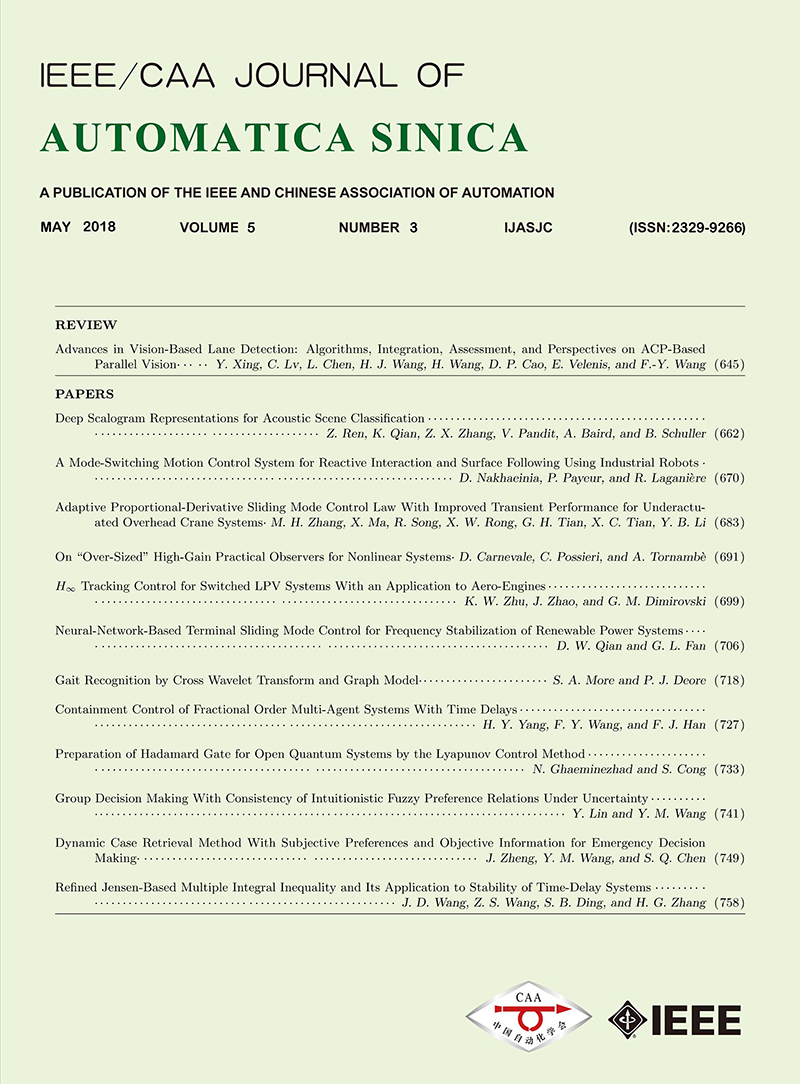 Volume 3
Issue 2
Volume 3
Issue 2
IEEE/CAA Journal of Automatica Sinica
| Citation: | Qingpeng Zhang and David Haglin, "Semantic Similarity between Ontologies at Different Scales," IEEE/CAA J. of Autom. Sinica, vol. 3, no. 2, pp. 132-140, 2016. |

| [1] |
Berners-Lee T, Hendler J, Lassila O. The semantic web. Scientific American, 2001, 284(5): 34-43
|
| [2] |
Maedche A, Staab S. Ontology learning for the semantic web. IEEE Intelligent Systems, 2001, 16(2): 72-79
|
| [3] |
Maedche A, Staab S. Measuring similarity between ontologies. In: Proceedings of the 13th International Conference on Knowledge Engineering and Knowledge Management: Ontologies and the Semantic Web. Sigöuenza, Spain: Springer-Verlag, 2002. 251-263
|
| [4] |
Allemang D, Hendler J. Semantic Web for the Working Ontologist: Effective Modeling in RDFS and OWL. San Francisco, CA, USA: Morgan Kaufmann Publishers Inc., 2008. 352
|
| [5] |
Hendler J, Holm J, Musialek C, Thomas G. US government linked open data: semantic.data.gov. IEEE Intelligent Systems, 2012, 27(3): 25-31
|
| [6] |
Al-Saffar S, Joslyn C, Chappell A. Structure discovery in large semantic graphs using extant ontological scaling and descriptive semantics. In: Proceedings of the 2011 IEEE/WIC/ACM International Conference on Web Intelligence and Intelligent Agent Technology (WI-IAT). Lyon, France: IEEE, 2011. 211-218
|
| [7] |
Shen Z, Ma K L, Eliassi-Rad T. Visual analysis of large heterogeneous social networks by semantic and structural abstraction. IEEE Transactions on Visualization and Computer Graphics, 2006, 12(6): 1427-1439
|
| [8] |
Dai B T, Kwee A, Lim E P. ViStruclizer: a structural visualizer for multidimensional social networks. In: Proceedings of the 17th Pacific-Asia Conference on Advances in Knowledge Discovery and Data Mining. Gold Coast, Australia: Springer, 2013. 49-60
|
| [9] |
Giereth M O. An Architecture for Visual Patent Analysis [Ph. D. dissertation], Universitöatsbibliothek der Universitöat Stuttgart: Stuttgart, 2013.
|
| [10] |
Gomes F, Devezas J, Figueira A' . Temporal visualization of a multidimensional network of news clips. Advances in Information Systems and Technologies. Berlin Heidelberg: Springer, 2013. 157-166
|
| [11] |
Kienreich W, Wozelka R, Sabol V, Seifert C. Graph visualization using hierarchical edge routing and bundling. In: Proceedings of the 3rd International Eurovis Workshop on Visual Analytics (EuroVA). The Eurographics Association, 2012.
|
| [12] |
Budanitsky A, Hirst G. Semantic distance in WordNet: an experimental, application-oriented evaluation of five measures. In: Proceedings of the 2001Workshop onWordNet and Other Lexical Resources, Second Meeting of the North American Chapter of the Association for Computational Linguistics. Pittsburgh, 2001.
|
| [13] |
Patwardhan S, Banerjee S, Pedersen T. Using measures of semantic relatedness for word sense disambiguation. In: Proceedings of the 4th International Conference on Computational Linguistics and Intelligent Text Processing. Mexico City, Mexico: Springer, 2003. 241-257
|
| [14] |
Song X B, Li L, Srimani P K, Yu P S, Wang J Z. Measure the semantic similarity of GO terms using aggregate information content. IEEE/ACM Transactions on Computer Biological Bioinformatics, 2014, 11(3): 468-476
|
| [15] |
Miller G A. WordNet: a lexical database for English. Communications of the ACM, 1995, 38(11): 39-41
|
| [16] |
Resnik P. Using information content to evaluate semantic similarity in a taxonomy. In: Proceedings of the 14th International Joint Conference on Artificial Intelligence. San Francisco, CA, USA: Morgan Kaufmann Publishers Inc., 1995. 448-453
|
| [17] |
Jiang J J, Conrath D W. Semantic similarity based on corpus statistics and lexical taxonomy. In: Proceedings of the 1977 International Conference on Research in Computational Linguistics (ROCLING X). Taiwan: China, 1997. 19-33
|
| [18] |
Lin D K. An information-theoretic definition of similarity. In: Proceedings of the 15th International Conference on Machine Learning. San Francisco, CA, USA: Morgan Kaufmann Publishers Inc., 1998. 296- 304
|
| [19] |
Pesquita C, Faria D, Falc~ao A O, Lord P, Couto F M. Semantic similarity in biomedical ontologies. PLoS Computational Biology, 2009, 5(7): e1000443
|
| [20] |
Schwering A. Approaches to semantic similarity measurement for geospatial data: a survey. Transactions in GIS, 2008, 12(1): 5-29
|
| [21] |
Schlicker A, Domingues F S, Rahnenföuhrer J, Lengauer T. A new measure for functional similarity of gene products based on gene ontology. BMC Bioinformatics, 2006, 7: 302
|
| [22] |
Lord P W, Stevens R D, Brass A, Goble C A. Semantic similarity measures as tools for exploring the gene ontology. Pacific Symposium on Biocomputing, 2003, 8: 601-612
|
| [23] |
Lee W N, Shah N, Sundlass K, Musen M. Comparison of ontologybased semantic-similarity measures. In: Proceedings of the 2008 AMIA Annual Symposium. American Medical Informatics Association, 2008. 384-388
|
| [24] |
Al-Mubaid H, Nguyen H A. Measuring semantic similarity between biomedical concepts within multiple ontologies. IEEE Transactions on Systems, Man, and Cybernetics, Part C: Applications and Reviews, 2009, 39(4): 389-398
|
| [25] |
Couto F M, Silva M J, Coutinho P M. Measuring semantic similarity between gene ontology terms. Data and Knowledge Engineering, 2007, 61(1): 137-152
|
| [26] |
Harris M A, Clark J, Ireland A, Lomax J, Ashburner M, Foulger R, et al. Gene ontology consortium. The gene ontology (GO) database and informatics resource. Nucleic Acids Research, 2004, 32(Database issue): D258-D261
|
| [27] |
North S C. Incremental layout in DynaDAG. Graph Drawing. Berlin Heidelberg: Springer, 1996. 409-418
|
| [28] |
Schlicker A, Albrecht M. FunSimMat: a comprehensive functional similarity database. Nucleic Acids Research, 2008, 36(Database issue): D434-D439
|
| [29] |
Erickson J S, Viswanathan A, Shinavier J, Shi Y M, Hendler J A. Open government data: a data analytics approach. IEEE Intelligent Systems, 2013, 28(5): 19-23
|